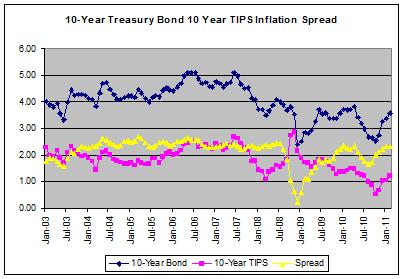Updated April 4, 2011
The TIPS/Treasury Bond spread is an oft-used metric to analyze inflation expectations. Analysts on CNBC, on the WSJ, and in other business media frequently refer to it. What is it? And what is it showing? Right now, the spread has returned to a pre-crisis level that shows neither heightened inflation nor deflation expectations.
What is the TIPS/Treasury Spread?
The TIPS/Treasury spread is the difference in yield between TIPS and Treasuries of the same duration. Click here for a good description of Treasury Inflation Protected Securities (TIPS). TIPS start off with a nominal yield, and the principle of the security is adjusted based on CPI inflation numbers. Thus, the TIPS yield is essentially stripped of its inflation factor, since this is added to the value of the security. Treasuries yields, on the other hand, are priced to anticipate future inflation. So, the premium that a Treasury pays over a TIPS is what the market expects inflation will be in the future and that is built into the yield. Subtracting the TIPS yield from the Treasury yield provides an indication of market inflation expectations.
If the spread shoots up, then that is an indication the market is expecting inflation. When it drops or goes negative, it indicates deflation fears. A negative reading, like what we saw in 2008 is a sign of severe market fear. Investors are not concerned with earning a return, but simply preserving capital by sticking money into ultra-safe Treasuries. That's exactly what we saw as the banking crisis scared many into parking cash into Treasuries, driving yields lower.
As the chart below shows, the spread between 10-year TIPS and 10 Year Treasury Bonds vaccilated in a range between 2.25% and 2.75%. Then, during the summer of 2008, the index plummeted, as the yield on Treasury Bonds dropped below the yield on TIPS. Such a reading is often interpreted as a sign of deflation fears. This, as well as other factors and metrics, led to the Federal Reserve lowering the Federal Funds Rate to 0% and unleashing a series of quantitive easing programs. In addition, the Federal Goverment passed the $800 billion American Recovery and Reinvestment Act of 2009. Looked at from the context of the chart below, the goal of these programs was to return the spread between these two bonds to pre-crisis levels and eliminate the fear of massive deflation. Deflation is what proved so pernicious during the Great Depression.

Is Inflation in the Cards?
Everyone is talking about a resurgance of inflation. That may be true, but right now there is no strong indication of that in the TIPS/Treasury spread. As you can see, the spread has recovered and is now in its "normal" range. Until Treasury bond yields begin to rise, which they haven't, it's safe to say that inflation expectations are muted. Excess capacity, unemployment, and a continued demand for US Treasuries mean that inflation is not as much of a slam dunk as the pundits seem to think.
I'll be monitoring the spread and will let you know if it changes or begins to show increased signs of inflation.



Add your Comment
or use your Google account
or use your BestCashCow account